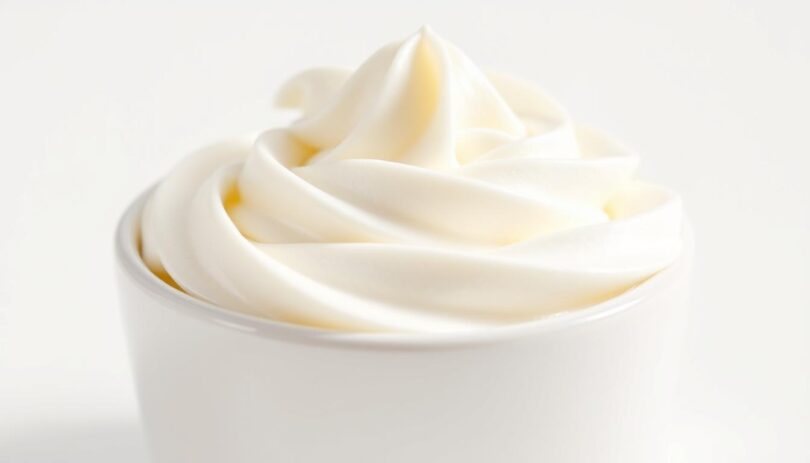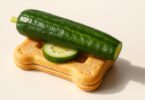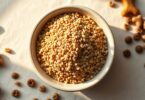Starbucks serves over 20,000 “Puppuccinos” daily – free cups of whipped cream for four-legged customers. This trend reflects a growing debate among pet owners about sharing human indulgences with their companions. While the fluffy topping isn’t toxic, its suitability requires careful evaluation.
Veterinarians like Dr. Dwight Alleyne emphasize moderation due to two primary concerns: high sugar content and excessive fat. A single tablespoon contains nearly 5 grams of fat – equivalent to 25% of a small dog’s daily needs. Overconsumption may lead to pancreatitis or obesity, especially in less active pets.
Lactose intolerance presents another consideration. Approximately 40% of canines struggle to digest dairy products effectively. Watch for symptoms like loose stools or excessive gas after initial tastings. Always consult your vet before introducing new foods, particularly for pets with known dietary sensitivities.
This guide combines nutritional science with practical feeding strategies. You’ll learn how occasional small portions might fit into a balanced diet while discovering healthier alternatives. Let’s explore how to enjoy special moments with your pet without compromising their wellbeing.
Understanding Whipped Cream as a Treat for Dogs
The creamy texture of whipped cream makes it tempting to share, but its ingredients warrant a closer look for pet safety. Typical recipes combine heavy dairy products like cream with sugar and flavorings – components that don’t align with canine dietary needs.
Ingredients and Nutritional Breakdown
Commercial whipped cream contains three primary elements: cream (30-40% fat), refined sugar, and stabilizers. A single tablespoon delivers 50 calories – equivalent to 10% of a small dog’s daily energy requirement. Dairy-based products introduce lactose, a sugar many pets struggle to digest. While puppies produce lactase enzymes to process milk, most adult animals lose this ability.
Why Moderation is Key
Veterinary nutritionists stress that occasional licks pose minimal risk for healthy animals. However, regular consumption disrupts gut health due to high fat and sugar concentrations. These ingredients may trigger pancreatitis or weight gain over time. For lactose-sensitive companions, even small amounts could cause bloating or diarrhea.
Dr. Emily Thompson, a board-certified veterinary internist, advises: “Treats shouldn’t exceed 10% of daily calories. For whipped cream, that means less than a teaspoon for toy breeds.” This measured approach allows pet parents to share special moments without compromising nutritional balance.
Can Dogs Eat Whipped Cream? Examining the Facts
When 62% of pet owners admit to sharing human foods with their companions, understanding treat safety becomes critical. While whipped cream isn’t classified as toxic dogs should avoid, its suitability depends on portion control and individual health factors.
Small Portions and Occasional Treats
A dollop smaller than a teaspoon works for most adult pets. Veterinary nutritionist Dr. Sarah Jennings notes: “Infrequent treats help prevent calorie overload – think monthly rewards, not daily habits.” This approach keeps fat intake below 10% of total calories.
Watch for signs like lethargy or changed bathroom patterns after initial tastings. These clues help determine if your pet handles dairy well. Always start with lick-sized amounts before considering repeat servings.
Health Considerations for Lactose-Intolerant Dogs
Nearly half of adult canines lack sufficient lactase enzymes. Dr. Michael Torres explains: “Even safe dogs without allergies might experience stomach discomfort from dairy sugars.” Symptoms typically appear within 12 hours – gas or loose stools signal intolerance.
For sensitive pets, try lactose-free alternatives or single-ingredient treats. Remember: non-toxic dogs reactions don’t equate to nutritional appropriateness. Rotate treat options to maintain dietary balance while satisfying their curiosity.
Potential Risks When Sharing Whipped Cream with Your Dog
While sharing treats creates bonding moments, certain ingredients demand caution. The fluffy texture hides components that might disrupt your pet’s health. Two primary concerns dominate veterinary discussions: metabolic strain and hidden toxins.
Hidden Dangers in Sweet Toppings
High sugar content strains a pet’s pancreas, potentially triggering inflammation. Excessive fat slows digestion, causing temporary diarrhea or vomiting. These digestive issues often appear within hours of consumption.
Xylitol presents a silent threat. Found in sugar-free varieties, this sweetener causes rapid blood sugar drops. Even small amounts risk liver failure. Always check labels before offering human foods.
Watch for bloating or lethargy after treats. Persistent symptoms require immediate vet attention. Remember: occasional licks might be harmless, but repeated exposure builds risk.
Choose plain varieties without additives if sharing. Better yet, explore pet-safe alternatives for guilt-free indulgence. Your companion’s wellbeing always comes first.
Spotlight on Puppuccinos: A Canine Treat Trend
Social media feeds brim with photos of eager snouts buried in Starbucks' signature espresso cups. These viral moments spotlight Puppuccinos – dollops of whipped topping served gratis to four-legged patrons. What began as barista Rocky Kanaka's spontaneous gesture in 2008 has become a nationwide ritual, blending coffee culture with pet parenting trends.
History and Popularity at Starbucks
The Puppuccino phenomenon reflects modern pet culture's shift toward inclusive experiences. Starbucks baristas report preparing hundreds daily, often customizing servings in petite cups to match animal sizes. Viral TikTok videos showing tails wagging over foam-topped treats helped cement this offering as a fan-favorite.
Guidelines for Safe Serving
Veterinarians recommend treating Puppuccinos like birthday cake – special but sparse. A standard espresso cup portion contains about two tablespoons, equivalent to 20% of a toy breed's daily fat allowance. Dr. Lisa Jennings advises: “Space these indulgences weeks apart and monitor stool consistency afterward.”
Always verify ingredients with baristas, as some locations use sweetened varieties. For pets with sensitive stomachs, request plain whipped products without flavor syrups. Remember: these creamy treats delight companions but shouldn't replace nutritionally balanced snacks.
Comparing Whipped Cream with Other Dairy Treats
Not all dairy treats are created equal, and knowing their impact is crucial for a pet's health. While both popular options appear in treat discussions, their nutritional profiles differ significantly. Understanding these variations helps owners make informed choices.
Sour Cream vs Whipped Cream
A 100-gram serving of the fluffy topping contains 257 calories compared to sour cream's 198. Both rank high in fat content, but the aerated dairy product packs nearly 20% more sugar. Veterinarian Dr. Renee Streeter notes: “These differences matter when considering occasional indulgences.”
Sour cream offers more riboflavin, supporting energy metabolism, while sweetened versions often contain additives. The lighter texture makes airy dairy treats easier to serve, explaining their popularity as quick rewards. However, sugar-free varieties sometimes hide xylitol – a dangerous sweetener for animals.
For pets needing lower carbohydrate intake, sour cream might seem preferable. Yet its thicker consistency and higher fat concentration pose digestion challenges. Some pet parents experiment with homemade recipes using plain yogurt or cottage cheese, avoiding heavy creams and butter. This approach controls fat and sugar content while ensuring safety.
Always check labels for hidden sugars or artificial additives. Whether using store-bought or homemade options, moderation remains vital. As Dr. Streeter advises: “Treats should complement a balanced diet, not compete with it.”
Dos and Don'ts: How to Safely Serve Whipped Cream
Balancing indulgence with safety starts with clear portion guidelines. Treats should enhance bonding moments without undermining nutritional goals. Follow these evidence-based strategies to share responsibly while prioritizing animal wellness.
Proper Serving Sizes and Frequency
Veterinary guidelines suggest limiting sweet toppings to a pea-sized portion for small breeds. Larger animals might handle up to half a teaspoon monthly. Consistency matters – irregular treats prevent calorie creep in a dog diet.
Measure servings at home using kitchen tools rather than eyeballing amounts. A baby spoon helps control size for precise dosing. Freeze small dollops on parchment paper for portion-controlled rewards.
Space indulgences at least four weeks apart. Frequent exposure trains pets to expect sugary treats, making balanced nutrition harder. Alternate with vet-approved snacks like carrot sticks or apple slices.
Watch for signs of upset like unusual lethargy or digestive changes. These reactions help parents gauge individual tolerance. When in doubt, skip the topping and opt for safer alternatives.
Always consult your veterinarian before introducing new foods. They’ll assess health history and suggest personalized limits. Remember: occasional treats spark joy, but daily habits risk long-term consequences.
Alternatives to Whipped Cream for a Healthier Dog Diet
Exploring nutritious swaps for traditional indulgences helps maintain tail wags without compromising wellness. Many pet-safe foods offer similar textures and flavors while supporting better health outcomes. These alternatives particularly benefit companions with sensitive digestion or dietary restrictions.
Dairy-Free Options and Pet-Safe Treats
Coconut-based toppings provide creamy satisfaction without lactose-related issues. Brands like The Honest Kitchen’s Bone Broth Toppers mix hydration with flavor. Unsweetened pumpkin puree or mashed banana also work well as occasional toppings.
For store-bought solutions, look for veterinary-approved snacks with minimal additives. Freeze-dried liver bits or salmon crumbles deliver protein-rich rewards. Always check labels for hidden sugars or artificial sweeteners that might cause issues.
Homemade Treat Recipes
Create simple frozen delights using lactose-free yogurt blended with blueberries. Pour into silicone molds for portion-controlled treats. Another pet parent favorite combines mashed sweet potato with oatmeal – bake into bite-sized cookies.
Try this crowd-pleaser: mix plain canned pumpkin with peanut butter and rolled oats. Roll into balls and refrigerate. These foods provide fiber and nutrients while satisfying your pup’s craving for something special.
Remember to introduce new items gradually. Monitor your pup’s reactions to ensure they tolerate ingredients well. Rotating options keeps mealtime exciting while maintaining nutritional balance.
Final Thoughts on Whipped Cream for Your Furry Friend
Responsible pet parenting means balancing special moments with nutritional wisdom. While occasional licks might fit some animals' diet, frequent indulgences risk vomiting or long-term health issues. Always prioritize vet-approved portions over trendy treats.
Key takeaways? Moderation prevents most problems. Even safe dogs shouldn’t consume sugary toppings regularly. Watch for artificial sweeteners like xylitol – dangerous for all pets. Consider healthier alternatives when possible.
Every animal reacts differently. Monitor energy levels and digestion after dogs eat rich foods. If symptoms appear, pause treats and consult your veterinarian. Remember: what’s harmless for one pet could harm another.
Ultimately, informed choices protect your companion’s wellbeing. Occasional rewards strengthen bonds without becoming habits. Whether opting for dairy or alternatives, let science guide your generosity. Happy tails begin with mindful care!
FAQ
Is lactose intolerance common in pets?
Many animals struggle to digest dairy due to low lactase enzyme production. While some tolerate small amounts, others experience diarrhea or vomiting. Monitor reactions after introducing any dairy product.
What makes puppuccinos potentially problematic?
Starbucks’ popular dog treat often contains high sugar levels and artificial additives. Always request no added sweeteners and limit portion sizes to avoid gastrointestinal distress.
How does whipped cream compare to butter for canine consumption?
Both contain high fat content, but butter’s denser consistency poses greater pancreatitis risks. Whipped varieties have slightly lower fat concentration per serving but still require strict moderation.
Are there hidden toxins in store-bought toppings?
Some brands use xylitol, an artificial sweetener lethal to animals. Always check labels and opt for homemade versions using heavy cream without additives for safer occasional treats.










Leave a Comment